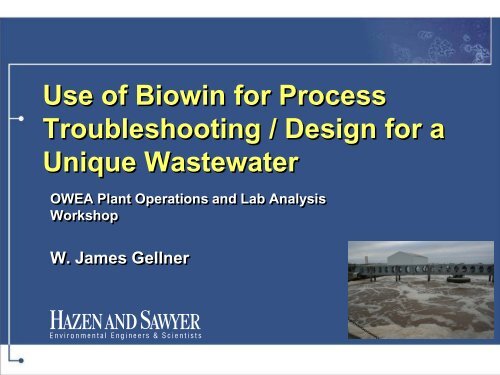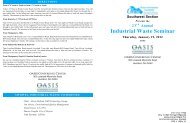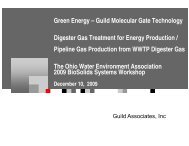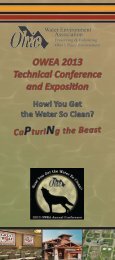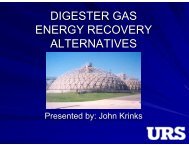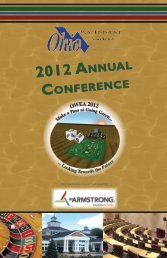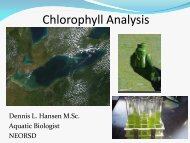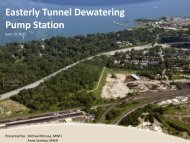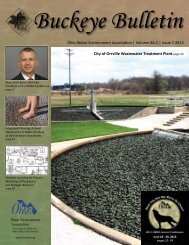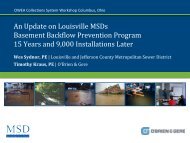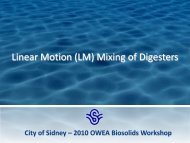Use of Biowin for Process Troubleshooting / Design for a Unique ...
Use of Biowin for Process Troubleshooting / Design for a Unique ...
Use of Biowin for Process Troubleshooting / Design for a Unique ...
- No tags were found...
Create successful ePaper yourself
Turn your PDF publications into a flip-book with our unique Google optimized e-Paper software.
<strong>Use</strong> <strong>of</strong> <strong>Biowin</strong> <strong>for</strong> <strong>Process</strong><strong>Troubleshooting</strong> / <strong>Design</strong> <strong>for</strong> a<strong>Unique</strong> WastewaterOWEA Plant Operations and Lab AnalysisWorkshopW. James Gellner
Outline• Introduction / Problem Overview– Plant Issues– <strong>Biowin</strong> Overview• Special Sampling• Simulations <strong>for</strong> Plant <strong>Troubleshooting</strong>• Simulations <strong>for</strong> Upgrade <strong>Design</strong>• Summary / Conclusions
Plant Overview• Turkey processing plant• 37,000 turkeys per day• Direct discharge permit• Repeated ammonia andsolids violations led toIDEM Agreed Order• ATS hired to per<strong>for</strong>mCPE
Plant SchematicCHEMICAL ADDITION(pH & Alkalinity Control,Hydrated Lime)PROCESSING PLANT(Kill Through Deboning– Including AllScreening)ANAEROBICLAGOONS / FLOWEQUILIZATION(2.24 MG, 8.52 MG)ACTIVATEDSLUDGE TANK(0.83 MG)CLARIFICATIONTANK(0.22 MG)TERTIARYFILTRATION(SchrelberFuzzy Filter, 0.4microns)DISINFECTION(UV)CASCADEAERATIONRASEMERGANCYBYPASSEFFLUENTWASAEROBIC LAGOONS /BACKUP FLOWEQUILIZATION(9.07 MG)
Effluent RequirementsParameter 30 Day Concentration(mg/l)Daily Concentration(mg/l)BOD 5 20 30Total Suspended Solids 20 30Ammonia (summer) 0.93 1.85Ammonia (winter) 1.77 3.54Oil and Grease 10 15E coli 125/100 mls 235/100 mlspH> 6.0 S.U. and < 9.0 S.U.Dissolved Oxygen > 6 mg/l winter> 5 mg/l summer
Influent LoadingsParameter Average Daily MaximumFlow 0.61 MGD 1.20 MGDBOD5 3860 lb/day (760 mg/l) 8060 lb/dayCOD 8190 lb/day (1610 mg/l) 13300 lb/dayTSS 1120 lb/day (220 mg/l) 2070lb/dayNH3 790 lb/day (155 mg/l) 1620 lb/dayAlkalinity 3120 lb/day (610 mg/l) 5280 lb/day
ATS / Hazen and Sawyer• 11/2008• CPE / <strong>Process</strong> Evaluation– Detailed sampling &analysis• DAF implementation• <strong>Design</strong> <strong>of</strong> improvements
Ammonia / Solids Violations• Repeated (inconsistent operations)• Overwasting <strong>of</strong> biological solids• Lagoon solids slugs• Overfeed <strong>of</strong> lime to biological system• Poor settling – filaments• “FLIP!”
BioWin OverviewInfluent (Eff ANA#2) Influent Mixer RAS MixerSchreiber MLSS Tank Final ClarifierFC EffluentLimeRAS/WAS SplitterWAS• Full plant simulation s<strong>of</strong>tware• ASDM – Activated Sludge/AnaerobicDigestion (IWA)• Graphical user interface– <strong>Use</strong>r friendly, Windows style• Requires detailed characterization
BioWin Overview (cont)• Steady state / dynamicsimulations• Tailored to domesticwaste• Ability toimport/export data• Allows multiplesimulations <strong>for</strong> what-ifand process sizinganalysis
Why <strong>Use</strong> <strong>Biowin</strong>?• <strong>Process</strong> troubleshooting tool– Evaluate effect <strong>of</strong> solids on system per<strong>for</strong>mance• Operations staff education– Simulations provide good examples <strong>for</strong>operations staff• <strong>Design</strong> tool– Size / optimize new processes <strong>for</strong> improvements
Special Sampling• Characterize influent• Capture processconditions• Allow <strong>for</strong> accuraterepresentation <strong>of</strong>process per<strong>for</strong>mance
COD ComponentsTotal CODBiodegradableUnbiodegradableSolubleParticulateSolubleParticulate
TKN ComponentsTotal TKNFree AmmoniaOrganic NitrogenBiodegradableUnbiodegradableSolubleParticulateSolubleParticulate
“The Filtration Tree”Symbol Filter RepresentationXX Not filtered Represents total sample (withparticulate and soluble)XG Glass fiber –1.5 micronXMMembranefilter – 0.45micronXF Flocculated /filtered with0.45 micronTraditional breakpointbetween particulate andsolubleDifference between XM andXG represents colloidal<strong>Use</strong>d to estimate readilybiodegradable material(COD)
Special Sampling Overview• 3 days <strong>for</strong> each event• Composite sampling• <strong>Process</strong> grabs at 9am and 9pm• Total <strong>of</strong> ~ 400 samples andanalysis• Special sampling per<strong>for</strong>med inJune (prior to DAF) and inSeptember 2009 (after temp DAFinstallation)
Sampling SchematicCHEMICAL ADDITION(pH & Alkalinity Control,Hydrated Lime)PROCESSING PLANT(Kill Through Deboning– Including AllScreening)ANAEROBICLAGOONS / FLOWEQUILIZATION(2.24 MG, 8.52 MG)INSTALLEDDAFACTIVATEDSLUDGE TANK(0.83 MG)CLARIFICATIONTANK(0.22 MG)TERTIARYFILTRATION(SchrelberFuzzy Filter, 0.4microns)DISINFECTION(UV)CASCADEAERATIONRASEMERGANCYBYPASSEFFLUENTDAFSLUDGESAMPLE LEGENDWASGRABCOMPOSITEAEROBIC LAGOONS /BACKUP FLOWEQUILIZATION(9.07 MG)
Special Sampling ResultsConstituent1 st Sampling EventUnfiltered (mg/l)2 nd Sampling EventUnfiltered (mg/l)TSS 165 154COD 1513 1294BOD 5 623 520CBOD 5 529 421TKN 221 234NH 3 129 183NOxN 0.5 0.43NO 2 N 0 0.05TP 34.8 36.6PO 4 P 10.4 11.7Ca +2 28.4 91.1Mg +2 10.3 13.8
Influent FractionsFbs - Readily biodegradable (including Acetate) [gCOD/g <strong>of</strong>total ]Default1 st event 2 nd event0.27 0.560 0.515Fac - Acetate [gCOD/g <strong>of</strong> readily biodegradable ] 0.15 0.000 0Fxsp - Non-colloidal slowly biodegradable [gCOD/g <strong>of</strong> slowlydegradable ]0.5 0.150 0.27Fus - Unbiodegradable soluble [gCOD/g <strong>of</strong> total ] 0.08 0.083 0.058Fup - Unbiodegradable particulate [gCOD/g <strong>of</strong> total ] 0.13 0.283 0.29Fna - Ammonia [gNH3-N/gTKN] 0.75 0.582 0.606Fnox - Particulate organic nitrogen [gN/g Organic N] 0.5 0.250 0.25Fnus - Soluble unbiodegradable TKN [gN/gTKN] 0.02 0.020 0.02FupN - N: ratio <strong>for</strong> unbiodegradable part. [gN/gCOD] 0.035 0.035 0.035Fpo4 - Phosphate [gPO4-P/gTP] 0.75 0.297 0.32FupP - P: ratio <strong>for</strong> influent unbiodegradable part. [gP/gCOD] 0.011 0.560 0.515
<strong>Biowin</strong> SetupDAF - FutureInfluent (Eff ANA#2) Influent Mixer RAS MixerSchreiber MLSS Tank Final ClarifierFC EffluentLimeRAS/WAS SplitterWAS• June 2009 data used <strong>for</strong> troubleshooting• September 2009 data used <strong>for</strong> process sizing
“Lime Solids” ScenariosInfluent (Eff ANA#2) Influent Mixer RAS MixerSchreiber MLSS Tank Final ClarifierFC EffluenLimeRAS/WAS SplitterWAS• Lime feed varied to increase CaCO 3 solids inreactor• CaCO 3 model• pH modeling turned <strong>of</strong>f to accommodateprecipitate model
“Lime Solids” Results18018160CaCO 3 Solids = 3500 mg/l16Clarifier Effluent NH3N (mg/L)140120100806040MLSS = 4500 mg/lTemperature = 10.2 deg CCaCO 3 Solids = 2500 mg/l141210864VSS SRT (Days)Effluent NH320VSS SRT (days)2000.00 500.00 1,000.00 1,500.00 2,000.00 2,500.00MLVSS (mg/L)
“Lagoon Solids” Scenarios• Influent solids <strong>of</strong> 100, 160, 300, 600, 1000– Ratio’d solids in influent fractions & COD• MLSS <strong>of</strong> 2000 & 3500 mg/l• Three different temperatures• No change in soluble constituents
“Lagoon Solids” Results - Winter160Steady State Simulations with Influent Q (0.6 MGD) and T=9.74oC140Schrieber Tank Effluent NH3N (mg/L)120100806040200100 167 300 600 1000Schreiber Tank Influent TSS (mg/L)3,500 mg/L MLSS 2,000 mg/L MLSS
“Lagoon Solids” Results - Average80Steady State Simulations with Influent Q (0.6 MGD) and T=17.73oC70Schrieber Tank Effluent NH3N (mg/L)6050403020100100 167 300 600 1000Schreiber Tank Influent TSS (mg/L)3,500 mg/L MLSS 2,000 mg/L MLSS
“Lagoon Solids” Results - Summer1.40Steady State Simulations with Influent Q (0.6 MGD) and T=26.07oC1.20Schrieber Tank Effluent NH3N (mg/L)1.000.800.600.400.200.00100 167 300 600 1000Schreiber Tank Influent TSS (mg/L)3,500 mg/L MLSS 2,000 mg/L MLSS
<strong>Process</strong> Recommendations• Permanent DAF – effluent 100 mg/l TSS• LSI control strategy• Denitrification tank / WAS Storage– Increase / recover alkalinity– Prevent “float”• Chemical feed / flocculation / splitter• New settling tank• NRCY / RAS Pump Station
Reactor Sizing SimulationsInf (Eff ANA#2) DAF Carbon Bypass Splitter Inf & NRCY Mixer RAS Mixer Anoxic_1 Carbon Bypass Mixer Schreiber Tank NRCY Splitter FCFC EffLimeRAS/WAS SplitterDAF Solids (back to lagoon)WAS• Added denitrification reactor to <strong>Biowin</strong>• Evaluated COD removal and NO 3 reduction
Reactor Sizing - Effluent NitrateAnoxic Reactor HydraulicRetention Time (based on Q =0.61)Simulated Effluent NitrateConcentration (mg/l)0 hrs (no anoxic zone) 1854 hrs 1206 hrs 938 hrs 7916 hrs 59NOTES:MLSS = 3000 mg/lTemp = 9.74 deg CInternal recyle rate <strong>of</strong> 300 % <strong>of</strong> influent flow rate
Reactor Sizing COD Consumption4,500Filtered COD Consumed in Anoxic Reactor, (ppd, COD-XG)4,0003,5003,0002,5002,0001,5001,0005000COD Removed = 700 mg/lCOD Removed = 550 mg/l3,000 mg/L MLSS - T=9.74oC3,000 mg/L MLSS - T=17.73oC4 6 8 16Anoxic HRT (hours, Inf Q)
Reactor Sizing – Effluent Ammonia1.802701.60240Simulated Clarifier Effluent NH3N, (mg/L)1.401.201.000.800.600.40Efflent NH3N- w/o AXEfflent NH3N - AX HRT = 6hrs2101801501209060Simulated Clarifier Effluent NO3, (mg/L0.200.00Efflent NO3N - w/o AXEfflent NO3N - AX HRT = 6hrsQ = 0.61 MGDAnoxic HRT = 6 hoursTemperature = 9.74 deg C3,000 2,750 2,500 2,250 2,000300MLSS (mg/L)
Reactor Sizing – Internal Recycle140120FC Effluent NO3N, (mg/L)1008060402000% 50% 100% 200% 300%NRCY (%, Inf Q)Q = 0.61 MGDAnoxic HRT = 6 hoursTemperature = 9.74 deg C
Reactor <strong>Design</strong>
Current Status• Under construction• Complete by 3/31/2011
Summary / Conclusions• <strong>Biowin</strong> useful as a tool in bothtroubleshooting and design– Illustrative tool– Multiple simulations allows <strong>for</strong> processoptimization• Effectiveness <strong>of</strong> model dependent oncharacterization• Tailored to domestic, but can be “flexed” <strong>for</strong>industrial wastes and unique sidestreams
Questions?jgellner@hazenandsawyer.com


